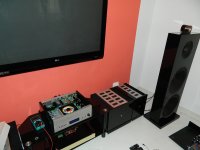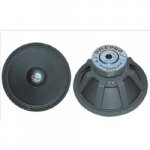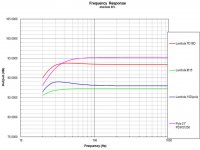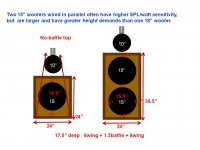Either very large diameter - 30" I'll guess or very heavy membrane = low SPL.
An OB will probably never go lower that 40 Hz, unless you have a very large room, and will need heavy eq., or very wide baffle.
Not sure how that exactly related to my advice of getting a low fs mid qts woofer. I didn't say much about <40Hz and high SPL...unless there was a specific request in the original post that I missed 😕
The lower you go, the more excursion you need - a LOT more excursion. OR you need more surface area (..i.e. more drivers). OR of course a combination of the two. (..close-coupling to the floor can also help somewhat.)
There is a tactile sensation that goes somewhat missing with an open baffle design. I prefer a transition from mid-bass to bass at around 70 Hz.
I'm enjoying my 4 21" woofer very much right now (supposed 7mm xmax). I'll be d@mned if I don't have good <30Hz output. The kids watched Transformers 2 the other day and the output was very impressive.
As far as tactile sensation, I complete agree. Once I get everything setup,my two subwoofer towers will play everything <30Hz to give the house good rumble 😀
I have noticed though that at night I can have more bass playing (with open baffles) without disturbing the kiddos. Couldn't do that with the ported subs...
thanks guys
those are very informative.
one more question, can i get away with passive xo for open baffle? i have no other choice but to go active xo?
regards,
erwin
those are very informative.
one more question, can i get away with passive xo for open baffle? i have no other choice but to go active xo?
regards,
erwin
thanks guys
those are very informative.
one more question, can i get away with passive xo for open baffle? i have no other choice but to go active xo?
regards,
erwin
You can do this passive. But it's generally more difficult, plus it wastes a LOT of efficiency.
This is a driver reasonably well suited to OB bass (not sub-bass), that has efficiency to burn:
Haut-parleur medium ERS TS38-800PRO
You'd need two though (per loudspeaker) for the xmax vs surface area, maybe more - ask someone to model it with Martin King's worksheets..
..shipping's not going to be cheap though. 😱
If you want to go active there is minidsp for the eq.. That plus a cheap amp with lots of power should work well with just about any driver you can think of.
This is an interesting driver for OB:
http://www.europe-audio.com/Product.asp?Product_ID=4486
You drive one coil "passive" integrated with the rest of your loudspeaker (i.e. just a low-pass filter for the driver as a part of the loudspeaker's crossover), and the other active with eq. for bass boost and room-mode adaption, AND still have a reasonably efficient 1 watt 1 meter output. You still couldn't drive it very low in freq. though at higher spl's.. THAT would require more drivers.
Last edited:
Not sure how that exactly related to my advice of getting a low fs mid qts woofer. I didn't say much about <40Hz and high SPL...unless there was a specific request in the original post that I missed 😕
You need som efficieny to compensate for the OB loss, and since a mid Q woofer with fs below 30 Hz will probably be around 90 dB you will end up with 80-84 dB sensitivity.
A woofer with mid Q and Fs around 40 Hz is easyer to find when high sensitivity is also important. The loss down to Fs will be 6 dB per octave and below it will be 18 dB per octave. You will there for have very good performance down to 40 Hz, and with the correct room also usable information lower than 40 Hz.
I think that most listenings rooms with a OB will not be able to reproduce much lower that 40 Hz anyway because og the cancelation from the rear wall.
You need som efficieny to compensate for the OB loss, and since a mid Q woofer with fs below 30 Hz will probably be around 90 dB you will end up with 80-84 dB sensitivity.
A woofer with mid Q and Fs around 40 Hz is easyer to find when high sensitivity is also important. The loss down to Fs will be 6 dB per octave and below it will be 18 dB per octave. You will there for have very good performance down to 40 Hz, and with the correct room also usable information lower than 40 Hz.
I think that most listenings rooms with a OB will not be able to reproduce much lower that 40 Hz anyway because og the cancelation from the rear wall.
Ah - I think I must've not followed your reply very well. I'd agree with that 🙂
thanks guys
those are very informative.
one more question, can i get away with passive xo for open baffle? i have no other choice but to go active xo?
regards,
erwin
You can do this passive. But it's generally more difficult, plus it wastes a LOT of efficiency.
FWIW, I'm running my 21" MCMs passive right now, ~12db/oct 70Hz lowpass via F-mod inline filter - efficiency truly went down the drain. My Behringer EP2000 starts to clip with the drivers still asking for a bit more.
Hi
Don't use the alpha 15a only if you want one note bass. The magnet
is to small. I will be selling mine soon hate them
RegardS
I agree.
If you want tight dynamic clean and with all the tonal colours of a bass guitar consider something else.
What about the Beta 12A ? These have twice the magnet size than the Alphas... I plan to drive them active...
I have 4 beta 12A's which I plan to use with a pair of these Monacor 200x full ranges which I intend to invert so one HF is firing rear, one forwards which I will drive actively with a Behringer DCX2496 Ultradrive when I have worked out how to use it 🙂
I have 4 beta 12A's which I plan to use with a pair of these Monacor 200x full ranges which I intend to invert so one HF is firing rear, one forwards which I will drive actively with a Behringer DCX2496 Ultradrive when I have worked out how to use it 🙂
Are you not really thinking about an IB, not "open"? There are some very good forums dedicated to IB subs. You will find what parameters are important, then pick the driver. You can't pick by brand.
If you can use a 21" woofer.
The Pyle PDW21250 21" subwoofer sells for less than $200 USD. There have been earlier reports of inconsistent T/S parameters, likely from out-of-spec parts and poorly controlled manufacturing processes. This driver was recently tested at Parts Express using a WT3 which produced the following specifications:
Fs: 27 Hz
Re: 7.8
Qts: 0.66
Qes: 0.89
Qms: 2.6
Le: 3.3 mH @ 1 kHz
Vas: 27 cubic feet
Mms: 150 gr.
Xmax: 8mm
DC R: 6.3
Similar T/S specs have been obtained from measurement by diyAudio members. I attached an XBAFFLE simulation of the Pyle21 and a few Lambda Dipole speakers for comparison.
The Pyle PDW21250 21" subwoofer sells for less than $200 USD. There have been earlier reports of inconsistent T/S parameters, likely from out-of-spec parts and poorly controlled manufacturing processes. This driver was recently tested at Parts Express using a WT3 which produced the following specifications:
Fs: 27 Hz
Re: 7.8
Qts: 0.66
Qes: 0.89
Qms: 2.6
Le: 3.3 mH @ 1 kHz
Vas: 27 cubic feet
Mms: 150 gr.
Xmax: 8mm
DC R: 6.3
Similar T/S specs have been obtained from measurement by diyAudio members. I attached an XBAFFLE simulation of the Pyle21 and a few Lambda Dipole speakers for comparison.
Attachments
Has anyone tried to build subwoofer out of these: http://www.thomann.de/dk/eminence_beta15.htm They are 60€ each if you buy two or more.
I was planning to use two of them in OB or h-frame, for music in 35-100hz range. Active eq of course.
Is it even worth trying? ps. sorry to hijack the thread
ps. sorry to hijack the thread
I was planning to use two of them in OB or h-frame, for music in 35-100hz range. Active eq of course.
Is it even worth trying?
 ps. sorry to hijack the thread
ps. sorry to hijack the threadDon't use the alpha 15a only if you want one note bass.
I had a similar experience, but the Eminence beta 15 worked very well for me.
Qts ~ .7 and a low Fr seems to be the ticket.
😎
If you're looking for an inexpensive 21" here is another option:
MCM Audio Select 21'' Die Cast Professional Woofer - 800W RMS | 55-2985 (552985) | MCM Audio Select
MCM Audio Select 21'' Die Cast Professional Woofer - 800W RMS | 55-2985 (552985) | MCM Audio Select
I was planning to use two of them in OB or h-frame, for music in 35-100hz range.
I have ten Lambda TD15D dipole woofers in our home. Wiring two TD15Ds in parallel delivers good SPL/watt efficiency, but a very large, very high H-frame cabinet. Today I would purchase six TD18D dipole woofers to get "good" efficiency with a shorter cabinet and superior wavefront launch.
The Lambda TD18D is a great "lifetime" dipole woofer. There are a few low cost 18" and 21" woofers like the Pyle PDW21250 that model well as both efficient and cost effective dipole bass. A $200 Pyle PDW21250 seem worth diyAudio evaluation.
JohnK's musicanddesign.com white papers on controlled directivity dipoles, like the NaO NOTE are worth study. I have been experimenting with 0.7" - 1.2" wide dipole ribbon tweeters which can Xover at 900Hz in an effort to meet JohnK's Fd demands with a 3-way dipole. (I love my Lambda TD10D midbass). Nude baffles and digital equalization .... dipole speaker research is still alive! An H-frame dipole woofer with a 18" - 21" will give you the foundation to experiment.
Attachments
For those in Europe this is a good source of drivers which get good reviews form people...
HTH AD-Audio bersichtsliste
They have a 21 inch too...
HTH AD-Audio bersichtsliste
They have a 21 inch too...
Mr. Busch just can't keep quite!
Ahh... Open Baffle woofer selection! What follows has been said previously, ad nauseam. However, after reviewing this thread, I feel the need to post the following thoughts.
I have tested at least 3 dozen different woofers ranging from 10" up to 21". The majority of these were 15" & 18" and include several mentioned in this thread. Any one of them, if correctly implemented, can provide good to excellent results. Measured, on baffle QTS values have ranged from .235 up to 1.8. After modeling, building and listening to all of the above, correct woofer choice and viability boiled down to implementation.
And before implementation comes your personal design - performance goals. I am, of course, over stating the obvious. One can just play, experiment and so on and hope to stumble on to a usable configuration. Luck if you will. Complicating things are each individuals personal combination of technical and material skills. For $140 or so you can build an amazingly competent 2 way OB. It will use big cheap drivers on a large simple baffle with a 5-or 6 component passive crossover. Not much for cosmetics (WAF), but a very satisfying music reproducer. A number of us have been there and done that.
Back to overstating the obvious. In order to make a reasonable woofer selection, you need to make some basic decisions about what you want to accomplish. The usual speaker design issues. How much money, how big, cosmetics, passive or active crossover (or a combo of the two), single, dual or quad woofer set ups, single full range, two or 3 way, partnering equipment, listening preferences, listening room realities and so on.
Until you get a handle on what you want and can personally do, picking a given woofer VS any other is a fools errand. (Unless you just want to experiment)
I do not want my comments to come off as condescending. Hopefully they will help focus the design - build process. Once you have focus, then meaningful woofer recommendations can be made. One of the underrated aspects of OB is that it offers the designer far more flexibility than close box systems. And you can easily, quickly and inexpensively "mock up" a potential system in heavy card board. Listen, measure, adjust, learn. Part of the fun. So, what do you really want to do??
Ahh... Open Baffle woofer selection! What follows has been said previously, ad nauseam. However, after reviewing this thread, I feel the need to post the following thoughts.
I have tested at least 3 dozen different woofers ranging from 10" up to 21". The majority of these were 15" & 18" and include several mentioned in this thread. Any one of them, if correctly implemented, can provide good to excellent results. Measured, on baffle QTS values have ranged from .235 up to 1.8. After modeling, building and listening to all of the above, correct woofer choice and viability boiled down to implementation.
And before implementation comes your personal design - performance goals. I am, of course, over stating the obvious. One can just play, experiment and so on and hope to stumble on to a usable configuration. Luck if you will. Complicating things are each individuals personal combination of technical and material skills. For $140 or so you can build an amazingly competent 2 way OB. It will use big cheap drivers on a large simple baffle with a 5-or 6 component passive crossover. Not much for cosmetics (WAF), but a very satisfying music reproducer. A number of us have been there and done that.
Back to overstating the obvious. In order to make a reasonable woofer selection, you need to make some basic decisions about what you want to accomplish. The usual speaker design issues. How much money, how big, cosmetics, passive or active crossover (or a combo of the two), single, dual or quad woofer set ups, single full range, two or 3 way, partnering equipment, listening preferences, listening room realities and so on.
Until you get a handle on what you want and can personally do, picking a given woofer VS any other is a fools errand. (Unless you just want to experiment)
I do not want my comments to come off as condescending. Hopefully they will help focus the design - build process. Once you have focus, then meaningful woofer recommendations can be made. One of the underrated aspects of OB is that it offers the designer far more flexibility than close box systems. And you can easily, quickly and inexpensively "mock up" a potential system in heavy card board. Listen, measure, adjust, learn. Part of the fun. So, what do you really want to do??
Thanks for info mr. Busch 🙂
What 18" woofer (or bigger) would you recommend in an u-baffel with active XO & DSP, being used from cirka 150 Hz and downwards?
I believe USD 350-400 per woofer is my financial the threshold per woofer.
Open for having more than one per side.
Br
Gisle
What 18" woofer (or bigger) would you recommend in an u-baffel with active XO & DSP, being used from cirka 150 Hz and downwards?
I believe USD 350-400 per woofer is my financial the threshold per woofer.
Open for having more than one per side.
Br
Gisle
- Home
- Loudspeakers
- Multi-Way
- Which 15 or 18 ınch woofer- best for open baffle




